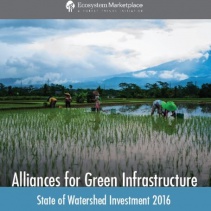Close To $25 Billion Spent To Secure Green Infrastructure Worldwide In 2015
As the global water crisis mounts, countries, cities and businesses funneled billions of dollars into market-based investments that conserve and restore forests, mangroves, wetlands and grasslands to secure reliable and clean water, says Ecosystem Marketplace’s latest report tracking watershed investments, released today.

15 December 2016 | Washington, D.C. | Governments, water utilities, companies, and communities around the world paid nearly US$25 billion (B) in 2015 for nature-based solutions to secure reliable access to clean water, according to a new report from Forest Trends’ Ecosystem Marketplace, Alliances for Green Infrastructure: State of Watershed Investment 2016.
From Beijing to Sao Paulo, and from Delhi to Los Angeles, cities and rural communities alike are struggling to maintain basic water services in the face of growing water scarcity, increasing floods and droughts, and other problems. Compounded by climate change and shrinking budgets, these challenges demand flexible, cost-effective solutions that can help close the “infrastructure gap” – the growing deficit between where water infrastructure investments now stand and where they need to be.
Alliances for Green Infrastructure tracks the growing popularity of a holistic water management approach that combines engineered “gray infrastructure” with “green infrastructure,” which includes healthy forests, wetlands, grasslands, and mangroves. This natural infrastructure can reduce flood risk, protect from storm damage, and help deliver drinking water, often at a fraction of the cost of strategies that focus exclusively on gray infrastructure.
According to the new report, programs in 62 countries made market-based investments in the natural ability of these ecosystems to ensure clean, reliable water supplies. These transactions might take the form of a government or business partnering directly with landholders near its water source – like a beverage company paying local farmers to reduce their pesticide use, saving money on on-site water treatment in the process – or paying into a local water fund.
The report found that the $24.7B spent in 2015 either protected, rehabilitated, or created new habitat on 486 million (M) hectares of land – an area 1.5 times the size of India – while also delivering “beyond-water” benefits including biodiversity conservation, climate adaptation, and sustainable land management training for local communities. Direct subsidy payments to public and private landholders accounted for most – $23.7B – of this total, as governments sought to encourage sustainable agriculture and other practices that support healthy watershed function.
“Governments around the world paid farmers and other private landholders nearly $10B in 2015 to reward them for good stewardship of lands critical to watershed health,” said report author Genevieve Bennett, Senior Associate at Forest Trends’ Ecosystem Marketplace. “Buoyed by ambitious commitments in China and efforts by the EU to make its agriculture subsidies ‘greener,’ we’re seeing the traditional agricultural subsidy model retrofitted for a green economy – to focus on landscape health and not just agricultural productivity.”
Another $675M came from water users themselves – cities, companies, or water utilities acting on behalf of customers – in an effort to proactively safeguard water supplies close to home. Cities and states moved to mitigate risks to water supplies, but were also motivated by the environmental and social co-benefits these projects delivered. Meanwhile, water utilities surveyed by Ecosystem Marketplace cited concerns about operational and maintenance costs as their core motivations for watershed investment. For the private sector, it was reputational and supply chain risks that often motivated action, particularly in the food and beverage sector, which spent about $9M in 2015. More broadly, the report highlights the growing popularity of corporate water stewardship, citing commitments by large, consumer-facing brands like Coca-Cola, SAB Miller, and IKEA.
The report also covers developments in other, more “market-like” mechanisms for watershed investment. Water quality trading and offsets programs jumped from $20.8M in transactions in 2013 to nearly $32M in 2015, hitting an all-time high. And environmental water markets, which connect buyers and sellers of water use rights seeking to restore water to overdrawn river systems and aquifers, saw the US surpass Australia for the first time as the worldwide leader in transactions ($48.4M as of 2015). Environmental water markets are becoming more flexible and accessible to private investors, according to the report, making them a promising mechanism for conservation finance in the coming years.
These watershed investments are steadily gaining momentum, with transactions growing about 12% per year on average between 2013 and 2015, but the report notes that uncertainty around future regulations ranked as the top concern among project respondents. It also highlights a need to increase technical and financial capacity at the ground level in order to unlock hundreds of millions of dollars that Ecosystem Marketplace finds is waiting in the wings for green infrastructure.
“This report confirms that investments to protect, restore, and enhance our water sources are flourishing around the world at a time when cost-effective infrastructure solutions are more critical than ever,” said Michael Jenkins, Founding President and CEO of Forest Trends. “A unique alliance of citizens, water utilities, companies, and governments are startting to recognize the benefits these investments deliver – from sink faucets all the way to corporate balance sheets.”
“These investments present an opportunity to – in one fell swoop – make our cities more resilient, our economies more sustainable, and our societies more equitable and healthy,” Jenkins added.
Please see our Reprint Guidelines for details on republishing our articles.

